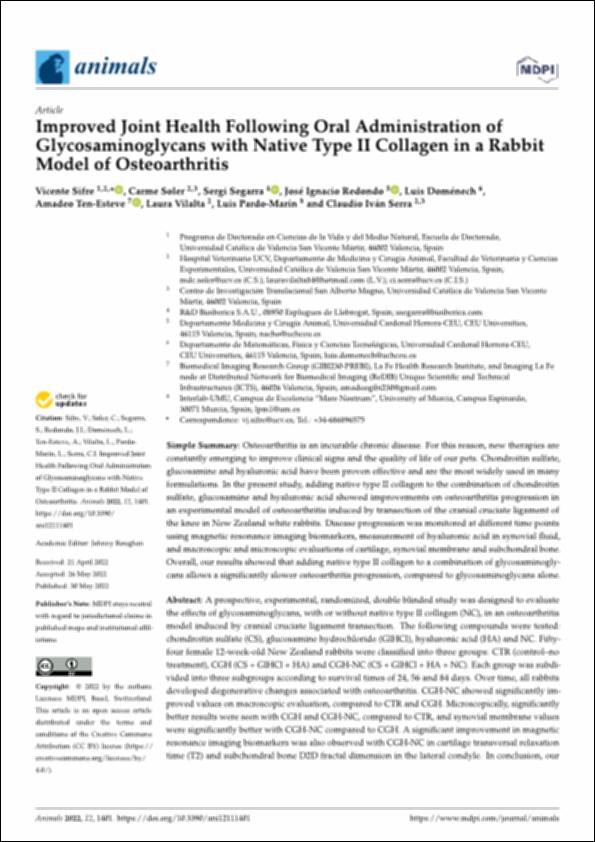Please use this identifier to cite or link to this item:
http://hdl.handle.net/10637/14194Improved joint health following oral administration of glycosaminoglycans with native type II collagen in a rabbit model of osteoarthritis
| Title: | Improved joint health following oral administration of glycosaminoglycans with native type II collagen in a rabbit model of osteoarthritis |
| Authors : | Sifre Canet, Vicente José Soler i Canet, María del Carme Segarra, Sergi Redondo García, José Ignacio Doménech Ballester, Luis Ten Esteve, Amadeo |
| Keywords: | Collagen - Therapeutic use.; Osteoartritis - Tratamiento.; Osteoarthritis - Treatment.; Antiinflamatorios no esteroideos.; Ácido hialurónico - Uso terapéutico.; Hyaluronic acid - Therapeutic use.; Nonsteroidal anti-inflammatory agents.; Colágeno - Uso terapéutico. |
| Publisher: | MDPI |
| Citation: | Sifre, V., Soler, C., Segarra, S., Redondo, J. I., Doménech, L., Ten-Esteve, A., Vilalta, L., Pardo-Marín, L. & Serra, C. I. (2022). Improved joint health following oral administration of glycosaminoglycans with native type II collagen in a rabbit model of osteoarthritis. Animals, vol. 12, i. 11 (30 may), art. 1401. DOI: https://doi.org/10.3390/ani12111401 |
| Abstract: | A prospective, experimental, randomized, double blinded study was designed to evaluate the effects of glycosaminoglycans, with or without native type II collagen (NC), in an osteoarthritis model induced by cranial cruciate ligament transection. The following compounds were tested: chondroitin sulfate (CS), glucosamine hydrochloride (GlHCl), hyaluronic acid (HA) and NC. Fiftyfour female 12-week-old New Zealand rabbits were classified into three groups: CTR (control–no treatment), CGH (CS + GlHCl + HA) and CGH-NC (CS + GlHCl + HA + NC). Each group was subdivided into three subgroups according to survival times of 24, 56 and 84 days. Over time, all rabbits developed degenerative changes associated with osteoarthritis. CGH-NC showed significantly improved values on macroscopic evaluation, compared to CTR and CGH. Microscopically, significantly better results were seen with CGH and CGH-NC, compared to CTR, and synovial membrane values were significantly better with CGH-NC compared to CGH. A significant improvement in magnetic resonance imaging biomarkers was also observed with CGH-NC in cartilage transversal relaxation time (T2) and subchondral bone D2D fractal dimension in the lateral condyle. In conclusion, our results show beneficial effects on joint health of CGH and CGH-NC and also supports that adding NC to CGH results in even greater efficacy. |
| Description: | Este artículo se encuentra disponible en la siguiente URL: https://www.mdpi.com/2076-2615/12/11/1401 Este artículo pertenece a la sección "Veterinary Clinical Studies". En este artículo de investigación también participan: Laura Vilalta, Luis Pardo-Marín y Claudio Iván Serra. |
| URI: | http://hdl.handle.net/10637/14194 |
| Rights : | http://creativecommons.org/licenses/by/4.0/deed.es |
| ISSN: | 2076-2615 (Electrónico) |
| Language: | es |
| Issue Date: | 30-May-2022 |
| Center : | Universidad Cardenal Herrera-CEU |
| Appears in Collections: | Dpto. Medicina y Cirugía Animal |
Items in DSpace are protected by copyright, with all rights reserved, unless otherwise indicated.


